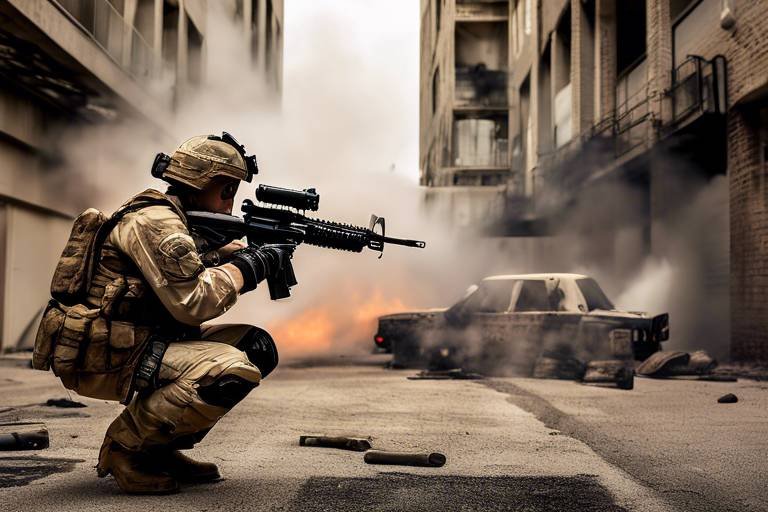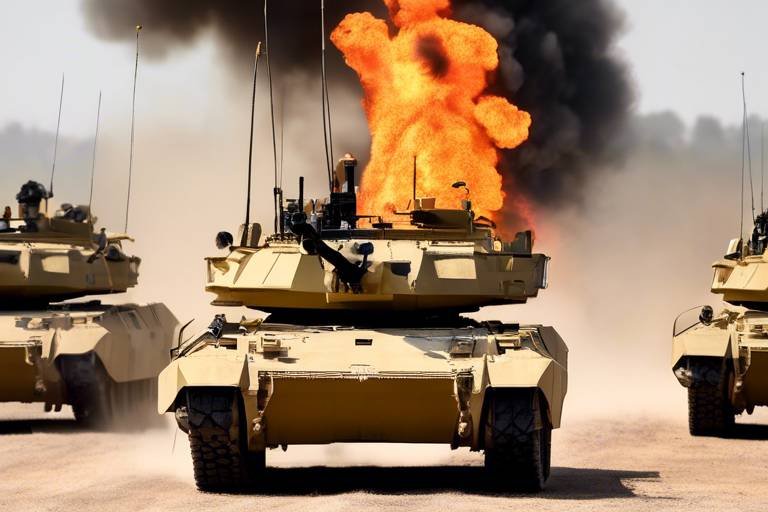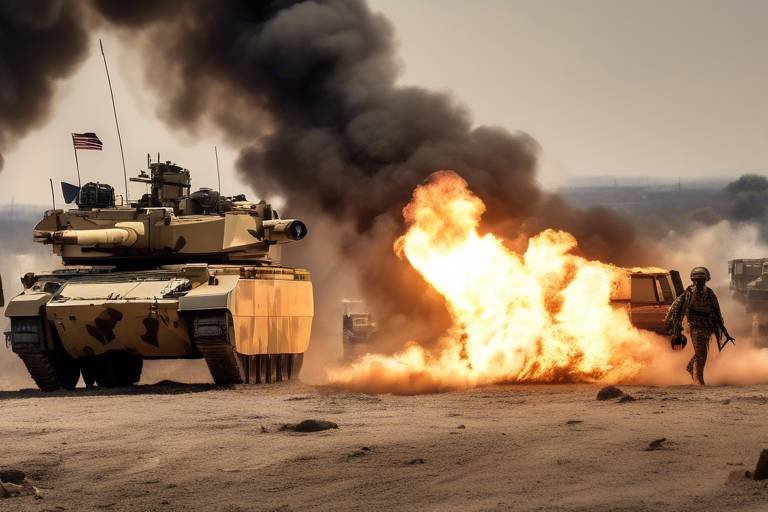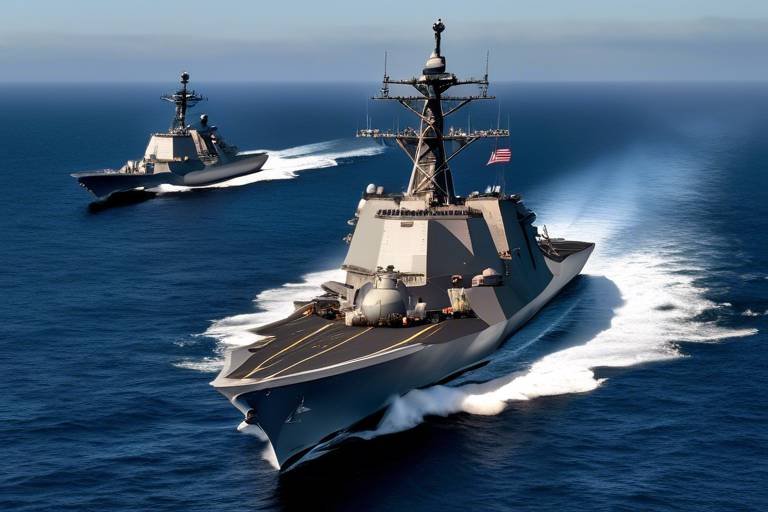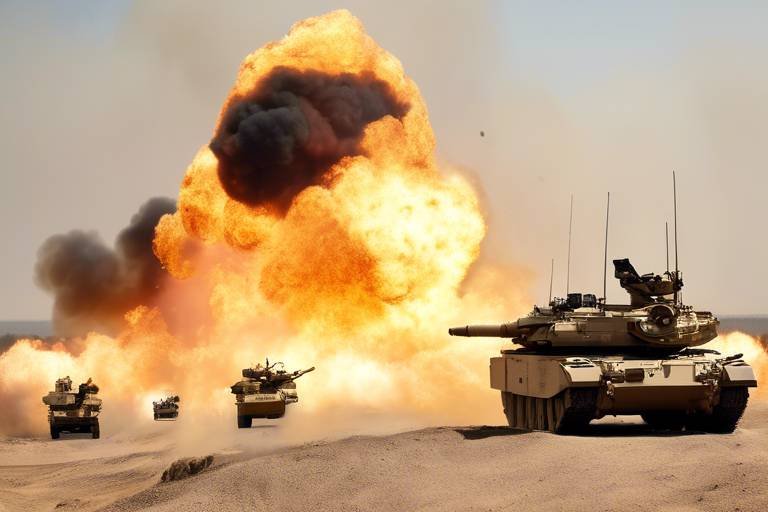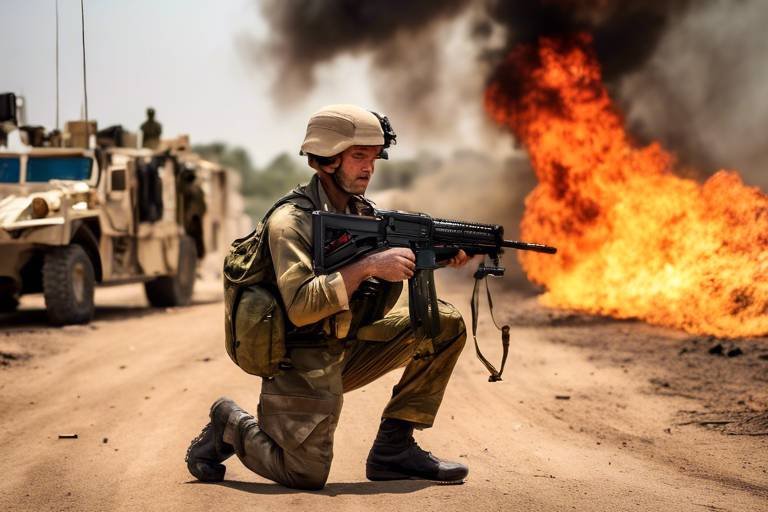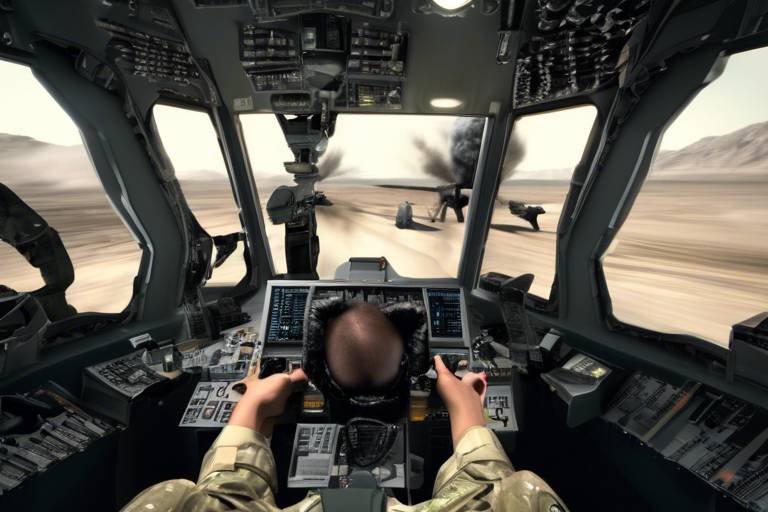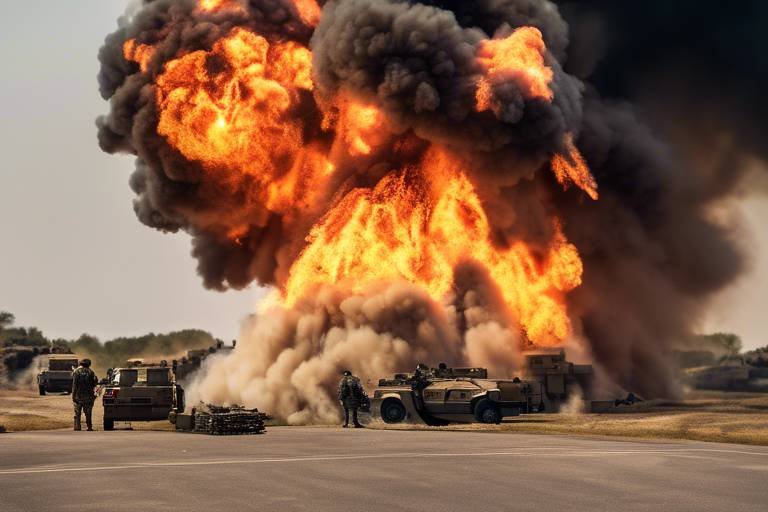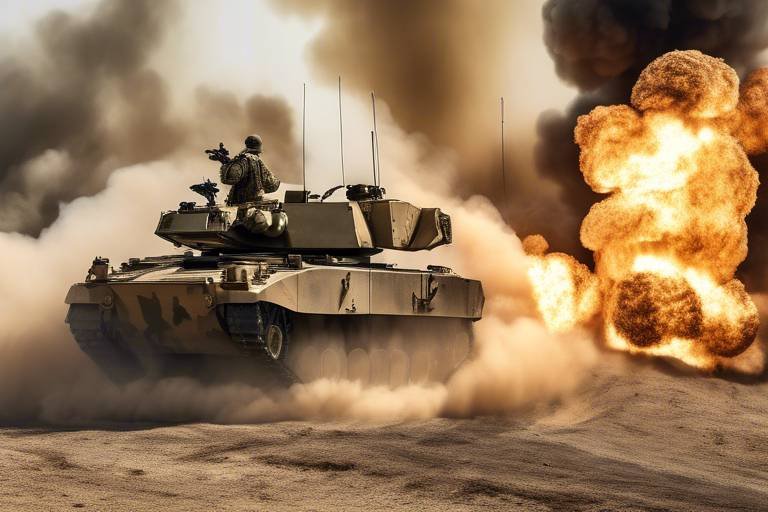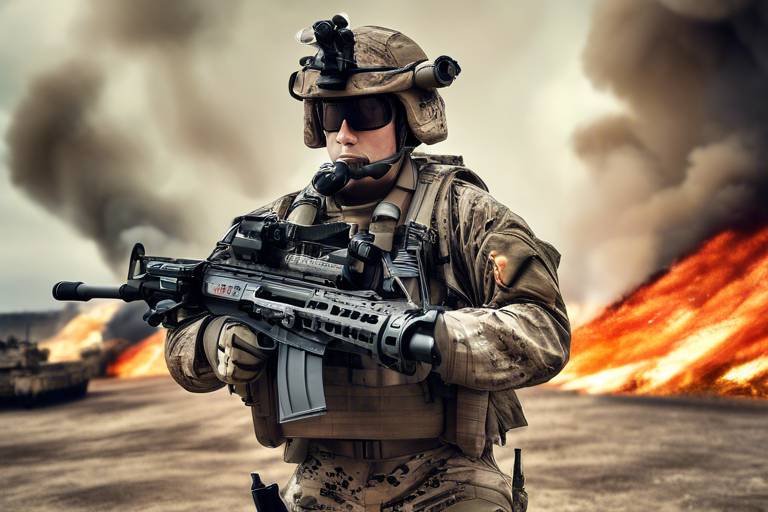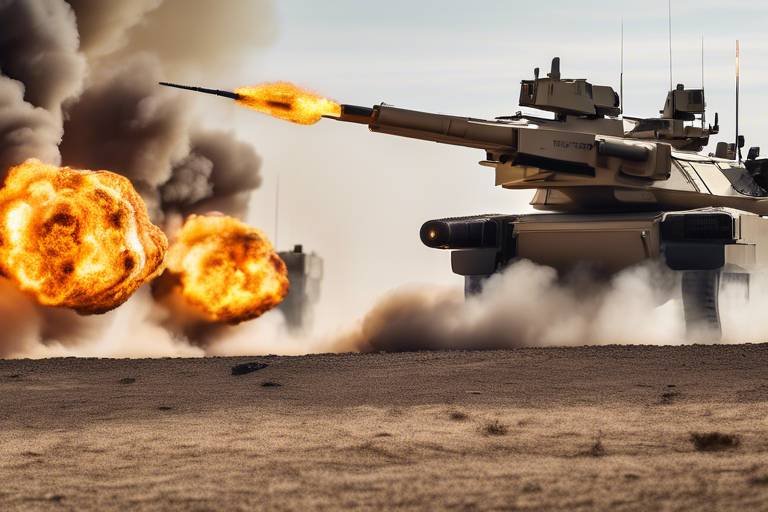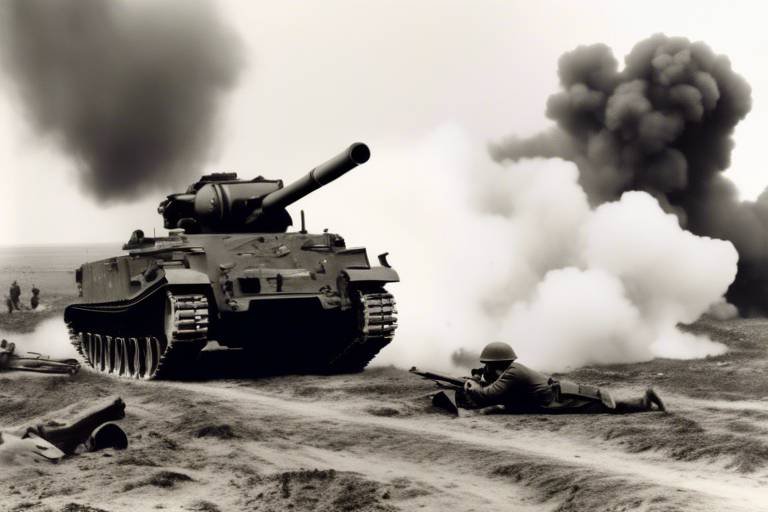Exploring the Challenges of Urban Combat for Firepower
Urban combat is a fascinating yet daunting arena that tests the mettle of military forces in ways that traditional battlefields do not. Imagine navigating a labyrinth of concrete and steel, where every corner could hide a threat, and every building could be a battleground. In these densely populated environments, the complexities of urban warfare become glaringly evident. The challenge lies not just in engaging the enemy but in doing so while safeguarding innocent lives and minimizing collateral damage. As we delve deeper into this topic, we'll explore the unique challenges urban combat presents, particularly concerning the utilization of firepower.
Urban warfare presents distinct challenges that require a nuanced understanding of the environment. The confined spaces of cities mean that military forces must adapt their strategies to deal with complex terrain and the ever-present risk of civilian casualties. In many cases, the battlefield is not just a traditional front line but a bustling city filled with people going about their daily lives. This dynamic significantly impacts tactical decisions, forcing commanders to weigh the benefits of firepower against the potential for harm to civilians. The urban landscape becomes a critical factor in shaping military operations, as forces must be prepared to engage in close-quarters combat, often in multi-story buildings and narrow alleyways.
The presence of civilians in urban combat zones complicates military operations in profound ways. It necessitates the development of strategies that prioritize the protection of non-combatants while still achieving operational effectiveness. Military personnel are often faced with difficult choices, balancing the need to neutralize threats with the imperative to avoid civilian casualties. This delicate dance requires not only tactical skill but also a strong ethical framework, as the consequences of their actions can reverberate far beyond the battlefield.
Rules of engagement (ROE) in urban combat are critical for ensuring compliance with international law. These rules are designed to balance military objectives with the need to protect civilian lives and property during operations. Commanders must be acutely aware of the ROE, as any deviation can lead to severe legal repercussions and damage to the military's reputation. The challenge is to maintain operational effectiveness while adhering to these guidelines, which can often be ambiguous in the chaos of urban warfare.
Legal considerations surrounding urban combat emphasize the importance of adhering to humanitarian law, which governs the conduct of armed forces in populated areas. This body of law is designed to prevent war crimes and protect those who are not participating in hostilities. Military forces must be trained to understand these legal frameworks, ensuring that their actions are not only effective but also justifiable under international law. The stakes are high, as violations can lead to war crimes charges and long-lasting consequences for both military personnel and their nations.
Ethical dilemmas arise in urban combat when military personnel must make split-second decisions that weigh operational success against potential civilian harm. Imagine a soldier in a tense standoff, faced with the choice of engaging a hostile target that could endanger innocent lives. These moments can lead to moral conflicts that challenge the very principles for which armed forces stand. The pressure to make the right call in the heat of battle can lead to significant psychological stress, highlighting the need for robust training and support systems.
To succeed in urban environments, military forces must adapt their tactics, employing specialized units and technology to navigate the complexities of city landscapes. This includes the use of small, agile units that can maneuver quickly and effectively in tight spaces. Additionally, technology plays a pivotal role in enhancing situational awareness and improving firepower effectiveness. The integration of drones, surveillance equipment, and advanced communication systems allows forces to gather intelligence and coordinate operations in real-time, making them more effective in urban combat scenarios.
Advancements in military technology, such as drones and precision-guided munitions, are transforming urban combat by enhancing situational awareness and reducing the risk of collateral damage. These innovations allow military forces to engage threats with greater accuracy and efficiency, ultimately improving operational outcomes.
The use of drones in urban combat has revolutionized reconnaissance and targeting. These unmanned aerial vehicles (UAVs) allow forces to gather intelligence from above, providing a bird's eye view of the battlefield. This capability enables commanders to make informed decisions while minimizing exposure to enemy fire. Drones can also deliver firepower with pinpoint accuracy, significantly reducing the risk of collateral damage and civilian casualties.
Smart munitions represent another leap forward in urban combat capabilities. These precision-guided weapons enable military forces to engage threats effectively without compromising safety. By utilizing advanced guidance systems, smart munitions can strike targets with incredible accuracy, ensuring that the surrounding civilian infrastructure remains intact. This technological edge is crucial in urban warfare, where the stakes are high, and the margin for error is minimal.
Urban combat presents unique logistical challenges, including supply chain management and the need for rapid resupply in dynamic and congested environments. The complexities of navigating dense urban landscapes can hinder the movement of troops and supplies, making effective logistical planning essential for sustained combat operations.
Effective supply chain management in urban combat zones is crucial for ensuring that troops receive necessary resources and equipment. This involves meticulous planning and coordination to navigate the challenges posed by urban infrastructure. Military logistics teams must be prepared to adapt quickly to changing circumstances, ensuring that soldiers on the ground have what they need to succeed.
Rapid resupply techniques, including the use of air drops and mobile supply units, are essential for maintaining operational momentum. In the fast-paced environment of urban combat, the ability to quickly replenish resources can mean the difference between success and failure. Military forces must be innovative and efficient in their logistical operations to support troops engaged in prolonged urban combat.
- What is urban warfare? Urban warfare refers to military operations conducted in urban environments, characterized by complex terrain and the presence of civilian populations.
- How do civilian populations impact military operations? The presence of civilians complicates military operations, requiring strategies that minimize collateral damage while achieving military objectives.
- What are the rules of engagement in urban combat? Rules of engagement are guidelines that dictate how military forces can engage with the enemy while ensuring the protection of civilians and compliance with international law.
- How has technology changed urban combat? Technological advancements, such as drones and smart munitions, have enhanced situational awareness and reduced the risk of collateral damage in urban combat scenarios.
Understanding Urban Warfare
Urban warfare is a multifaceted battlefield that challenges military forces in ways that traditional combat does not. Imagine navigating a maze of buildings, alleys, and rooftops, where every corner could hide an enemy or a civilian. This environment creates a unique set of challenges that can significantly impact tactical decisions and the effective use of firepower. The very nature of urban combat requires soldiers to be more than just warriors; they must also be tacticians, negotiators, and sometimes even peacekeepers.
One of the most pressing issues in urban warfare is the confined spaces in which combat occurs. Unlike open fields, urban environments are characterized by narrow streets and densely packed structures. This not only limits the movement of troops but also complicates the use of heavy weaponry. For instance, while a tank might be a formidable force on an open battlefield, its effectiveness diminishes in tight quarters where it can become trapped or vulnerable to ambush. In such scenarios, infantry units must rely on close-quarters combat tactics, often engaging in intense firefights that require quick reflexes and split-second decision-making.
Moreover, the presence of civilian populations adds another layer of complexity to urban warfare. Troops must constantly be aware of their surroundings, ensuring that their actions do not endanger innocent lives. This challenge necessitates the development of strategies that aim to minimize collateral damage while still achieving military objectives. For example, forces may use non-lethal tactics or intelligence-gathering operations to assess enemy positions before launching an attack. The goal is to strike effectively without causing unnecessary harm to civilians or damaging infrastructure that may be vital for post-conflict recovery.
In this chaotic environment, complex terrain plays a significant role in shaping military operations. Urban landscapes are often filled with obstacles, from rubble and barricades to underground tunnels and hidden passageways. This complexity requires soldiers to adapt their tactics continuously, utilizing specialized units trained for urban operations. For instance, some military forces employ specialized urban warfare units that are adept at navigating these challenging terrains, using advanced technologies such as drones and surveillance systems to enhance their situational awareness.
Ultimately, understanding urban warfare means recognizing that it is not just about firepower; it is about the careful orchestration of strategy, ethics, and technology. As military forces continue to adapt to the realities of urban combat, the lessons learned from past conflicts will shape future operations. The question remains: how can we balance the need for effective military action with the imperative to protect civilian lives? This ongoing dilemma underscores the importance of developing comprehensive urban warfare strategies that prioritize both operational success and humanitarian considerations.
Impact of Civilian Populations
The presence of civilians in urban combat zones creates a complex web of challenges that military forces must navigate with extreme caution. Unlike traditional battlefield environments, urban areas are teeming with life, and the stakes are significantly higher when it comes to civilian safety. Imagine trying to conduct a surgical operation in a crowded room—every move must be precise, and one misstep can lead to dire consequences. This reality forces military planners to rethink their strategies, ensuring that operational effectiveness does not come at the cost of innocent lives.
In urban warfare, the **dynamics of engagement** shift dramatically. Troops are often faced with the dilemma of engaging enemy combatants who may be intermingled with civilians. This necessitates the development of rules of engagement that emphasize restraint and the protection of non-combatants. The military's ability to differentiate between combatants and civilians is crucial, and this often relies on intelligence, surveillance, and reconnaissance (ISR) capabilities. For instance, **intelligence gathering** is essential to understanding the civilian landscape and making informed decisions about when and how to engage.
Moreover, the **psychological impact** of urban combat on civilian populations cannot be overstated. The fear and uncertainty that permeate the environment can lead to significant humanitarian crises. Civilians may become displaced, and access to essential services like food, water, and medical care can be severely compromised. This not only complicates military operations but also poses long-term challenges for post-conflict recovery and stabilization. The military must work alongside humanitarian organizations to address these challenges effectively.
To further illustrate the impact of civilian populations in urban combat, consider the following table that outlines key factors influencing military operations:
| Factor | Impact on Military Operations |
|---|---|
| Presence of Civilians | Increases risk of collateral damage and complicates target identification. |
| Urban Infrastructure | Can be used for cover by both civilians and combatants, complicating engagement rules. |
| Humanitarian Needs | Requires coordination with NGOs to ensure civilian safety and access to aid. |
| Psychological Effects | Can lead to increased hostility towards military forces and impact local support. |
In summary, the impact of civilian populations in urban combat zones is profound and multifaceted. Military forces are tasked not only with achieving their operational objectives but also with ensuring the safety and security of non-combatants. This balancing act requires innovative strategies, robust intelligence, and a commitment to humanitarian principles. Failure to adequately address these challenges can lead to devastating consequences, both during and after the conflict.
- What are the main challenges of urban warfare? Urban warfare involves confined spaces, the presence of civilians, and complex terrain, which all complicate military operations.
- How do military forces minimize civilian casualties? By employing strict rules of engagement, utilizing advanced technology, and coordinating with humanitarian organizations.
- What role do drones play in urban combat? Drones enhance reconnaissance and targeting capabilities, allowing for more precise engagement and reduced risk to civilian lives.
- Why is supply chain management critical in urban combat? Effective supply chain management ensures that troops receive necessary resources in dynamic and congested environments.
Rules of Engagement
The Rules of Engagement (ROE) in urban combat are not just a set of guidelines; they are the backbone of military operations in densely populated areas. As forces maneuver through the complexities of urban warfare, these rules ensure that every action taken is both tactical and ethical. Imagine navigating a maze where every corner could hide civilians or potential threats; this is the reality for soldiers in urban settings. The ROE serves as a compass, guiding military personnel in making decisions that align with both operational goals and humanitarian principles.
One of the primary objectives of the ROE is to minimize collateral damage. This is crucial because, in urban environments, the line between combatants and non-combatants often blurs. Soldiers are trained to identify threats while also being acutely aware of their surroundings. For instance, if a sniper is located in a residential building, the decision to engage must consider the potential risk to innocent lives. This balancing act is what makes urban combat so challenging. The ROE provides a framework that encourages troops to think critically and act judiciously, ensuring that military objectives do not come at the expense of civilian safety.
Furthermore, the ROE are influenced by international law and humanitarian principles. They are designed to comply with treaties such as the Geneva Conventions, which dictate the acceptable conduct of armed forces in populated areas. Understanding these legal parameters is essential for military personnel, as violations can lead to significant consequences, including war crimes charges. In essence, the ROE are not merely bureaucratic red tape; they are vital for maintaining the moral high ground in warfare.
However, the implementation of these rules is fraught with ethical dilemmas. Soldiers often face situations where they must make split-second decisions that could impact civilian lives. For example, if a soldier is under fire and identifies a legitimate target that is located near a group of civilians, the decision to engage can lead to moral conflicts. This is where the training and understanding of ROE become crucial. Military leaders emphasize the importance of situational awareness and the need for troops to constantly assess their environment before taking action. The ability to adapt and respond to the fluid dynamics of urban combat is what distinguishes effective military operations from those that are reckless and harmful.
In conclusion, the Rules of Engagement are not just a set of rules; they are an essential part of the operational framework that governs urban combat. They ensure that military actions are conducted within the bounds of legality and ethics while striving to achieve tactical success. As urban warfare continues to evolve, so too must the understanding and application of these rules, ensuring that soldiers can navigate the complexities of combat with both effectiveness and humanity.
- What are the Rules of Engagement?
The Rules of Engagement are directives that outline the circumstances and limitations under which military forces can initiate or continue combat with opposing forces.
- Why are ROE important in urban combat?
ROE are crucial in urban combat to minimize civilian casualties and ensure compliance with international law, balancing military objectives with the protection of non-combatants.
- How do ROE affect decision-making on the battlefield?
ROE guide soldiers in making informed decisions that consider both tactical needs and ethical implications, helping to prevent unnecessary harm to civilians.
- Can ROE change during a conflict?
Yes, ROE can be adapted based on the evolving situation on the ground, ensuring that military operations remain effective while adhering to legal and ethical standards.
Legal Considerations
The landscape of urban combat is fraught with legal complexities that military forces must navigate to ensure compliance with international humanitarian law. This set of laws is designed to protect those who are not participating in hostilities, including civilians, and to regulate the means and methods of warfare. In urban environments, where the lines between combatants and non-combatants often blur, understanding these legal considerations becomes paramount.
One of the primary legal frameworks governing urban warfare is the Geneva Conventions, which outline the protections afforded to civilians and the obligations of military forces to distinguish between combatants and non-combatants. Violating these laws can lead to severe repercussions, including accusations of war crimes. For instance, if a military operation results in significant civilian casualties or damages civilian infrastructure without a legitimate military objective, it could be deemed unlawful under international law.
Moreover, military commanders are often faced with the challenge of making quick decisions in high-pressure situations. The legal principle of proportionality plays a crucial role here. It requires that any military action taken must be proportionate to the anticipated military advantage gained. This means that even if a target is legitimate, the potential harm to civilians must be weighed against the military gain. This principle is not just a legal obligation; it is a moral imperative that underscores the ethical dimension of warfare.
In addition to the Geneva Conventions, other legal instruments, such as the Additional Protocols, provide further guidance on the conduct of hostilities. These protocols emphasize the need for precautionary measures to minimize harm to civilians and civilian objects. For example, the use of precision-guided munitions can be seen as a legal and ethical strategy to reduce collateral damage. However, the responsibility still lies with military leaders to ensure that such technologies are employed judiciously and in accordance with the law.
Ultimately, the legal considerations surrounding urban combat require a delicate balance between achieving military objectives and adhering to the principles of humanitarian law. Military personnel must be trained not only in tactical operations but also in the legal implications of their actions on the battlefield. This dual focus can help ensure that operations are conducted ethically and legally, thereby protecting the integrity of military forces and the rights of civilians caught in the crossfire.
- What are the Geneva Conventions?
The Geneva Conventions are a series of international treaties that establish standards for humanitarian treatment in war, protecting those who are not participating in hostilities.
- How does international law affect military operations in urban areas?
International law imposes obligations on military forces to protect civilians and to conduct operations in a manner that distinguishes between combatants and non-combatants.
- What is the principle of proportionality?
The principle of proportionality requires that the anticipated military advantage of an action must outweigh the potential harm to civilians and civilian infrastructure.
- What role do precision-guided munitions play in urban combat?
Precision-guided munitions are designed to accurately hit targets while minimizing collateral damage, making them a crucial tool in adhering to legal and ethical standards in urban warfare.
Ethical Dilemmas
In the chaotic environment of urban combat, military personnel often find themselves grappling with profound . These dilemmas can arise unexpectedly, forcing soldiers to make split-second decisions that pit operational success against the potential for civilian harm. Imagine being in a situation where you must decide whether to engage a hostile target that is dangerously close to innocent bystanders. This scenario is not just a theoretical exercise; it is a stark reality faced by many in the field.
One of the most pressing ethical issues in urban warfare is the balance between mission objectives and the protection of civilian lives. Soldiers are trained to achieve their goals, but when those goals involve the potential loss of innocent lives, the stakes become incredibly high. The pressure to act decisively can lead to moral conflicts, where the right choice is not always clear. This is akin to walking a tightrope, where one misstep can have devastating consequences.
Furthermore, the psychological toll of these decisions can be immense. Service members may experience guilt or trauma from actions taken during combat, particularly if those actions result in unintended civilian casualties. The haunting question, "Did I do the right thing?" can linger long after the dust has settled. This emotional burden is compounded by the knowledge that their choices may be scrutinized by the public and media, adding another layer of complexity to their already challenging roles.
To navigate these ethical waters, military leaders emphasize the importance of compliance with international humanitarian law. This legal framework is designed to protect civilians and minimize suffering during armed conflicts. Adhering to these laws is not merely a matter of legality; it is a moral imperative that shapes the conduct of military operations. However, the reality on the ground often complicates strict adherence to these laws, leading to difficult choices.
In summary, the ethical dilemmas faced in urban combat are multifaceted and deeply challenging. Soldiers must constantly weigh their operational goals against the potential consequences of their actions. The need for rapid decision-making in high-stress environments can lead to moral conflicts that are not easily resolved. As military forces continue to engage in urban warfare, understanding and addressing these ethical challenges will be crucial for maintaining both operational effectiveness and the moral high ground.
- What are the main ethical dilemmas faced in urban combat?
The main ethical dilemmas include balancing mission objectives with civilian safety, making quick decisions under pressure, and dealing with the psychological impacts of those decisions. - How does international humanitarian law apply to urban warfare?
International humanitarian law provides guidelines to protect civilians and minimize suffering, emphasizing the importance of distinguishing between combatants and non-combatants. - What is the psychological impact of ethical dilemmas on soldiers?
Soldiers may experience guilt, trauma, and moral conflict from their decisions, particularly if those decisions lead to civilian casualties. - How can military forces address these ethical dilemmas?
Military forces can address these dilemmas through training, adherence to humanitarian laws, and fostering a culture of ethical decision-making.
Tactical Adaptations
In the chaotic realm of urban combat, military forces must adapt their tactics to effectively navigate the unique challenges presented by city landscapes. Urban environments are not just a backdrop; they are a complex battlefield filled with high-rise buildings, narrow alleyways, and a multitude of obstacles that can hinder traditional military maneuvers. Imagine trying to fight a battle inside a giant maze—where every corner could hide an enemy or a civilian. This is why adaptability is not just a strategy; it’s a necessity.
One of the most significant tactical adaptations involves the formation of specialized urban warfare units. These units are trained specifically for close-quarters combat and are equipped with tools designed for urban environments. They utilize a combination of stealth, speed, and technology to engage the enemy while minimizing exposure. This is akin to a chess game, where each move must be calculated to avoid unnecessary casualties while still achieving the objective.
Moreover, the integration of technology plays a pivotal role in these adaptations. The use of drones for reconnaissance and surveillance allows forces to gather crucial intelligence without putting themselves in harm's way. Drones can scout enemy positions, monitor civilian movements, and even assist in targeting, all while keeping operators at a safe distance. This not only enhances situational awareness but also reduces the risk of collateral damage, which is a critical consideration in urban combat scenarios.
Additionally, the concept of combined arms operations becomes vital in urban settings. This approach involves the coordinated use of infantry, armor, and air support to maximize firepower while adapting to the dense environment. For instance, armored vehicles may be used to breach fortified positions, while infantry units can maneuver through tight spaces to secure buildings. This multi-faceted strategy ensures that forces can respond effectively to various threats while maintaining flexibility.
To illustrate the importance of these tactical adaptations, consider the following table that outlines some of the key strategies employed in urban combat:
| Strategy | Description |
|---|---|
| Specialized Urban Units | Trained for close-quarters combat with tailored equipment. |
| Drones | Used for reconnaissance and targeting to reduce exposure. |
| Combined Arms Operations | Coordinated use of different military branches to enhance effectiveness. |
| Intelligence Gathering | Utilizing technology and local informants to understand the battlefield. |
In conclusion, the evolution of tactics in urban combat is a response to the complex realities faced by military forces. By embracing specialized training, leveraging technology, and applying combined arms strategies, troops can navigate the treacherous urban landscape more effectively. The ability to adapt is not merely an advantage; it is the lifeblood of success in urban warfare.
- What are the main challenges of urban combat?
Urban combat challenges include confined spaces, the presence of civilians, and complex terrain that complicates tactical decisions. - How do military forces minimize civilian casualties?
Forces employ precision-guided munitions and strict rules of engagement to minimize collateral damage while achieving operational goals. - What role do drones play in urban warfare?
Drones enhance reconnaissance capabilities, allowing forces to gather intelligence and deliver firepower with greater accuracy. - What is combined arms operations?
This strategy involves the coordinated use of infantry, armor, and air support to maximize effectiveness in combat scenarios.
Technological Innovations
In the ever-evolving landscape of urban warfare, are playing a pivotal role in reshaping how military forces approach combat in densely populated areas. The integration of advanced technologies not only enhances the effectiveness of military operations but also aims to reduce the risks associated with civilian casualties. Imagine a scenario where a soldier can pinpoint enemy positions with pinpoint accuracy while ensuring the safety of innocent bystanders; this is the promise of modern technology in urban combat.
One of the most significant advancements has been the rise of drones. These unmanned aerial vehicles (UAVs) have transformed reconnaissance missions, allowing forces to gather vital intelligence without exposing personnel to danger. Drones equipped with high-resolution cameras can survey vast urban areas, identifying threats and mapping out the terrain in real-time. This capability is crucial in a city where every corner could harbor a potential enemy or a civilian caught in the crossfire.
Moreover, drones are not just for surveillance; they can also deliver firepower with remarkable precision. The ability to launch targeted strikes from the sky minimizes the risk of collateral damage, which is a significant concern in urban environments. For example, imagine a drone that can drop a bomb on a specific rooftop while ensuring that the surrounding buildings remain untouched. This level of accuracy is a game-changer in urban combat.
Another groundbreaking innovation is the development of smart munitions. Unlike traditional explosives, smart munitions are designed to adapt to their environment, allowing for precision strikes that significantly reduce the likelihood of civilian casualties. These munitions use advanced guidance systems to navigate complex urban landscapes, ensuring that they hit their intended targets with minimal risk to surrounding structures and people. Consider this: a smart bomb can adjust its trajectory mid-flight to avoid hitting a nearby school, demonstrating the potential of technology to mitigate the horrors of war.
However, with these advancements come new challenges. The reliance on technology in urban combat raises questions about cybersecurity and the potential for enemy forces to disrupt or hijack these systems. As military forces become more dependent on drones and smart munitions, the need for robust cybersecurity measures becomes paramount. Protecting these technologies from cyber threats is as crucial as the technology itself.
Furthermore, the integration of artificial intelligence (AI) into military operations is revolutionizing decision-making processes in urban combat. AI systems can analyze vast amounts of data from various sources, providing commanders with actionable insights in real-time. This capability allows for quicker responses to emerging threats, ensuring that military forces remain one step ahead of adversaries. However, the ethical implications of using AI in warfare cannot be overlooked. The question arises: how much autonomy should we grant machines in life-and-death situations?
In conclusion, the technological innovations reshaping urban warfare are a double-edged sword. While they promise enhanced operational effectiveness and reduced risks to civilian lives, they also introduce new complexities and ethical dilemmas. As military forces continue to adapt to these advancements, the balance between leveraging technology and maintaining humanitarian standards will be more critical than ever.
- What are drones used for in urban combat? Drones are primarily used for reconnaissance and targeted strikes, allowing military forces to gather intelligence and engage threats with precision.
- How do smart munitions work? Smart munitions utilize advanced guidance systems to navigate complex environments and ensure accurate strikes while minimizing collateral damage.
- What role does AI play in urban warfare? AI assists in analyzing data and providing real-time insights to commanders, enhancing decision-making processes in dynamic combat scenarios.
- What are the risks associated with technological innovations in warfare? Risks include cybersecurity threats, ethical concerns regarding AI autonomy, and the potential for increased reliance on technology in combat situations.
Drone Warfare
In the realm of urban combat, has emerged as a game-changer, fundamentally altering how military operations are conducted in densely populated areas. Imagine being able to survey an entire city block from the comfort of a control room miles away, all while minimizing the risk to personnel on the ground. Drones, or unmanned aerial vehicles (UAVs), offer unparalleled advantages in reconnaissance, target acquisition, and even direct engagement with enemy forces. They serve as the eyes in the sky, providing real-time intelligence that can make or break a mission.
The integration of drones into urban warfare strategies allows military forces to gather critical data without putting soldiers in harm's way. This capability is particularly vital in environments where civilian presence is significant. For instance, drones equipped with advanced sensors can identify enemy positions while simultaneously tracking civilian movements. This dual capability enables commanders to make informed decisions, balancing the need for tactical advantage with the imperative of minimizing civilian casualties.
Moreover, the precision with which drones can deliver firepower is astounding. Traditional airstrikes often come with a high risk of collateral damage, especially in urban settings where buildings and civilians are in close proximity. In contrast, drones can deploy precision-guided munitions that significantly reduce the likelihood of unintended harm. This technological advancement not only enhances operational effectiveness but also aligns with the ethical considerations that modern military forces must navigate.
However, the deployment of drones in urban combat is not without its challenges. The complexities of urban landscapes can interfere with drone operations, creating issues such as signal interference and restricted flight paths. Additionally, the potential for enemy countermeasures, such as anti-drone technology, poses a significant threat to UAVs. As a result, military planners must continually adapt their tactics and invest in research to overcome these obstacles.
In summary, represents a significant evolution in military strategy, particularly in urban environments. It enhances situational awareness and allows for precise engagements, ultimately redefining the rules of engagement in modern combat. As technology continues to advance, the role of drones will likely expand further, making them indispensable tools in the arsenal of military forces around the globe.
- What are the primary advantages of using drones in urban combat?
Drones provide real-time intelligence, enhance precision in targeting, and reduce the risk to personnel on the ground, all of which are critical in urban environments.
- How do drones minimize civilian casualties?
By utilizing precision-guided munitions and advanced surveillance capabilities, drones can engage threats more accurately, thus lowering the chances of collateral damage.
- What challenges do drones face in urban warfare?
Challenges include signal interference, restricted flight paths due to buildings, and the threat of enemy countermeasures.
Smart Munitions
In the realm of urban combat, the introduction of has been nothing short of revolutionary. These advanced weapons are designed to enhance precision and minimize collateral damage, making them an invaluable asset in densely populated environments. Imagine trying to hit a moving target in a crowded market; the stakes are incredibly high, and the consequences of a missed shot could be devastating. Smart munitions are engineered to tackle these challenges head-on, allowing military forces to engage threats effectively while safeguarding civilian lives.
Smart munitions utilize cutting-edge technology, such as GPS guidance, advanced sensors, and sophisticated algorithms, to ensure that they hit their intended targets with pinpoint accuracy. This capability is particularly crucial in urban settings, where the risk of civilian casualties is significantly heightened. Unlike traditional munitions, which may have a wide blast radius, smart munitions are designed to focus their explosive power on specific targets, thereby reducing the potential for unintended harm.
Moreover, the versatility of smart munitions allows for a range of applications in urban combat scenarios. They can be deployed from various platforms, including aircraft, ground vehicles, and even handheld launchers. This adaptability means that military forces can respond to threats rapidly and effectively, regardless of the situation. For instance, during a hostage rescue operation, a soldier might use a smart munition to neutralize an enemy combatant while ensuring that the surrounding area remains safe for civilians. The precision offered by these munitions can often be the difference between a successful operation and a tragic loss of life.
However, the use of smart munitions is not without its challenges. The reliance on technology raises questions about the potential for malfunctions or failures in the heat of battle. Additionally, the cost of developing and deploying these advanced weapons can be significant, leading to debates about resource allocation within military budgets. Nonetheless, the benefits they provide in terms of operational effectiveness and civilian protection often outweigh these concerns.
In conclusion, smart munitions represent a significant advancement in military technology, particularly in the context of urban warfare. Their ability to deliver precise strikes while minimizing collateral damage makes them an essential tool for modern military forces. As conflicts continue to evolve, the integration of smart munitions into combat strategies will likely play a crucial role in shaping the future of urban combat.
- What are smart munitions? Smart munitions are advanced weapons designed to hit specific targets with high precision, minimizing collateral damage in combat scenarios.
- How do smart munitions work? They utilize technology such as GPS guidance and advanced sensors to ensure accurate targeting and effective engagement of threats.
- What are the benefits of using smart munitions in urban combat? The primary benefits include reduced risk of civilian casualties, enhanced operational effectiveness, and the ability to adapt to various combat situations.
- Are there any drawbacks to using smart munitions? Yes, potential malfunctions and high development costs are concerns, but their advantages often outweigh these issues.
Logistical Challenges
Urban combat is a battlefield like no other, presenting a myriad of that can make or break a military operation. Imagine trying to navigate a maze where every turn could lead to a surprise encounter or an ambush. This is the reality for forces engaged in urban warfare, where the complexities of city landscapes add layers of difficulty to supply chain management and operational effectiveness.
One of the most significant logistical hurdles in urban combat is the need for rapid resupply. In a dynamic environment filled with crumbling buildings, narrow streets, and civilian populations, getting supplies to troops on the ground becomes a high-stakes game. Traditional supply routes can be blocked or destroyed, requiring innovative solutions to ensure that soldiers receive the necessary resources to sustain their operations. For instance, air drops can be a lifeline, allowing supplies to be delivered directly to troops without exposing them to enemy fire. However, this method is not without its risks, as precise targeting is crucial to avoid unintended casualties.
Moreover, the presence of civilians complicates logistical operations. Military planners must consider the safety and well-being of non-combatants when devising supply routes and resupply strategies. This often leads to the creation of alternative supply lines that prioritize stealth and discretion. In urban settings, the need for speed and efficiency is paramount, but so is the necessity to minimize the impact on civilian life. Balancing these competing demands requires a level of tactical ingenuity that is both challenging and essential.
To further illustrate the complexities involved, let’s take a look at a table that outlines some common logistical challenges faced in urban combat:
| Logistical Challenge | Description |
|---|---|
| Supply Chain Disruption | Blocked routes and damaged infrastructure can halt the flow of supplies. |
| Civilian Safety | Operations must be planned to avoid civilian casualties and property damage. |
| Resource Allocation | Determining the most effective distribution of limited resources in real-time. |
| Communication | Maintaining clear lines of communication in congested urban areas can be challenging. |
In addition to these challenges, urban combat requires military forces to adopt rapid resupply techniques. Traditional methods may not suffice in the fast-paced and often chaotic environment of a city. Mobile supply units, for instance, can be deployed to move quickly between combat zones, ensuring that troops have what they need when they need it. This flexibility is crucial for maintaining operational momentum, especially when engagements can last for extended periods.
Ultimately, the logistical challenges of urban combat are a test of innovation and adaptability. The ability to think on one’s feet and devise creative solutions can be the difference between success and failure on the battlefield. As military forces continue to face the realities of urban warfare, the lessons learned from these logistical challenges will shape future strategies and operations.
- What are the main logistical challenges in urban combat? Urban combat presents challenges such as supply chain disruption, civilian safety, resource allocation, and communication difficulties.
- How do military forces ensure civilian safety during operations? Military planners must devise alternative supply routes and strategies that prioritize civilian safety while maintaining operational effectiveness.
- What are rapid resupply techniques? Rapid resupply techniques include mobile supply units and air drops, which help deliver necessary resources quickly to troops in dynamic environments.
Supply Chain Management
Effective is the backbone of military operations, especially in the chaotic environment of urban combat. Imagine trying to navigate a bustling city while ensuring that troops have the necessary resources to engage in combat effectively. It's not just about getting supplies from point A to point B; it's about doing so efficiently and safely, often under fire. In urban warfare, the complexities multiply—narrow streets, towering buildings, and unpredictable civilian movement all pose significant challenges. To overcome these hurdles, military planners must employ innovative strategies that ensure a steady flow of ammunition, food, medical supplies, and equipment to frontline units.
One of the key aspects of supply chain management in urban combat is the need for real-time situational awareness. Commanders must have up-to-date information about the battlefield to make informed decisions. This means utilizing technology, such as GPS tracking and advanced communication systems, to monitor supply routes and adjust them as necessary. For instance, if a particular route becomes compromised due to enemy activity, commanders need the flexibility to reroute supplies quickly without losing momentum. This adaptability is crucial for maintaining operational effectiveness.
Moreover, in urban environments, the risk of ambushes and attacks on supply convoys is significantly heightened. Therefore, military forces often implement security measures to protect supply chains. This can include the use of armed escorts, reconnaissance missions to scout routes, and even the deployment of drones to monitor supply lines from above. The goal is to ensure that resources reach their destination without falling into enemy hands or being destroyed.
In addition to these logistical considerations, military planners must also address the psychological aspect of supply chain management. Troops in urban combat can experience heightened stress levels, and knowing that supplies are on the way can provide a significant morale boost. Regular updates about supply status and the assurance of timely resupply can enhance soldiers' confidence in their mission. Thus, effective communication within the supply chain not only ensures logistical success but also supports the mental well-being of the troops.
To summarize, effective supply chain management in urban combat is a multifaceted challenge that requires a blend of technology, strategy, and communication. By prioritizing real-time information, ensuring security, and maintaining troop morale, military forces can navigate the complexities of urban warfare while sustaining their operational capabilities.
- What are the key challenges of supply chain management in urban combat?
Urban combat presents challenges such as navigating congested areas, ensuring timely delivery under fire, and managing civilian presence. - How does technology improve supply chain management?
Technology enhances supply chain management through real-time tracking, communication systems, and surveillance, allowing for better route planning and security. - What role do drones play in supply chain logistics?
Drones can be used for reconnaissance of supply routes, monitoring for threats, and even delivering supplies to hard-to-reach areas.
Rapid Resupply Techniques
In the chaotic environment of urban combat, become a lifeline for military forces. Imagine a bustling city, where every street corner could hold a hidden enemy, and every building might serve as a fortress. In such scenarios, troops need to be equipped with the right resources at the right time, and traditional supply methods simply won't cut it. This is where innovative resupply strategies come into play, ensuring that soldiers remain combat-ready despite the challenges posed by densely populated areas.
One of the most effective methods for rapid resupply in urban settings is through the use of air drops. These operations involve dropping supplies from aircraft, which can be a game changer when ground routes are compromised. However, executing air drops in urban environments requires meticulous planning. Pilots must account for factors like wind, building heights, and the potential for civilian presence. To enhance safety and precision, military forces often use smart technology that allows them to pinpoint drop zones accurately, minimizing the risk of collateral damage.
Another technique gaining traction is the deployment of mobile supply units. These units are essentially agile supply trucks or armored vehicles that can navigate the congested streets of a city. Equipped with advanced navigation systems, these vehicles can quickly adapt to changing situations, delivering essential supplies directly to the front lines. The advantage of mobile units lies in their ability to respond to real-time needs, ensuring that troops receive critical supplies such as ammunition, food, and medical equipment without unnecessary delays.
Moreover, the integration of drone technology has revolutionized resupply operations. Drones can carry smaller loads directly to soldiers in hard-to-reach locations, bypassing obstacles that would slow down ground vehicles. This not only speeds up the resupply process but also reduces the risk of ambushes that ground convoys might face. The versatility of drones means they can be deployed for various tasks, from delivering ammunition to providing medical supplies, making them indispensable in urban warfare.
To further illustrate the effectiveness of these techniques, consider the following table that outlines the key advantages and challenges associated with each rapid resupply method:
| Resupply Method | Advantages | Challenges |
|---|---|---|
| Air Drops | Quick delivery, bypasses ground obstacles, can reach isolated troops | Requires precise targeting, risk of civilian harm, weather-dependent |
| Mobile Supply Units | Real-time response, direct delivery, adaptable routes | Vulnerable to ambushes, may face traffic congestion, limited by terrain |
| Drones | Fast, reduces ground risk, versatile for various supplies | Limited payload, potential for technical failure, requires airspace control |
In conclusion, the complexity of urban combat necessitates a reevaluation of traditional resupply methods. By embracing innovative techniques such as air drops, mobile supply units, and drone technology, military forces can maintain the momentum of operations while safeguarding the lives of their troops. The ability to adapt and respond quickly to the dynamic challenges of urban warfare is crucial for success on the battlefield.
- What are the main challenges of rapid resupply in urban combat?
Rapid resupply in urban combat faces challenges such as navigating congested areas, avoiding civilian casualties, and ensuring timely delivery amidst potential enemy threats. - How do air drops minimize risks in urban environments?
Air drops utilize smart technology for precise targeting, which helps to reduce the risk of collateral damage and ensures supplies reach the intended recipients safely. - What role do drones play in urban resupply operations?
Drones provide a fast and efficient means of delivering supplies directly to troops in challenging locations, reducing the risk associated with ground transport.
Frequently Asked Questions
- What are the main challenges of urban combat?
Urban combat presents a myriad of challenges, including confined spaces that limit movement and visibility, the presence of civilian populations that complicate engagement rules, and complex terrain that can hinder tactical maneuvers. These factors require military forces to adapt their strategies significantly to ensure effectiveness while minimizing risks.
- How do civilian populations affect military operations in urban areas?
The presence of civilians in urban combat zones creates a critical dilemma for military operations. Forces must develop strategies that prioritize the protection of civilians while still achieving their military objectives. This often leads to the implementation of advanced reconnaissance techniques and careful planning to avoid collateral damage.
- What are the rules of engagement in urban warfare?
Rules of engagement in urban warfare are essential for maintaining compliance with international law. They guide military personnel in making decisions that balance operational success with the imperative to protect civilian lives and property. These rules are designed to minimize harm and ensure that military actions are justified and proportionate.
- What legal considerations are involved in urban combat?
Legal considerations in urban combat focus on adherence to humanitarian law, which governs the conduct of armed forces in populated areas. This includes preventing war crimes and ensuring that military actions do not disproportionately affect civilian populations. Understanding these laws is crucial for commanders and troops operating in such environments.
- What ethical dilemmas do military personnel face in urban combat?
Military personnel often encounter ethical dilemmas in urban combat situations, where split-second decisions can have significant consequences. They must weigh the potential for operational success against the risk of civilian harm, leading to moral conflicts that challenge their values and training.
- How have military tactics adapted to urban environments?
Military forces have adapted their tactics for urban warfare by employing specialized units trained for close-quarters combat and utilizing technology to navigate complex city landscapes. This includes the integration of drones and precision-guided munitions to enhance firepower effectiveness while reducing risks to civilians.
- What role do technological innovations play in urban combat?
Technological innovations, such as drones and smart munitions, have transformed urban combat by improving situational awareness and enabling more precise strikes. These advancements help military forces gather intelligence and engage threats with greater accuracy, ultimately minimizing collateral damage and enhancing operational effectiveness.
- What are the logistical challenges in urban combat?
Urban combat presents unique logistical challenges, including the management of supply chains in congested environments and the need for rapid resupply to sustain operations. Effective logistical planning is crucial for ensuring that troops receive necessary resources in a timely manner, allowing them to maintain operational momentum.
- What techniques are used for rapid resupply in urban settings?
Rapid resupply techniques in urban combat may include air drops, mobile supply units, and the establishment of forward operating bases. These methods are essential for supporting troops engaged in prolonged combat, ensuring they have the supplies and equipment needed to operate effectively in dynamic situations.

